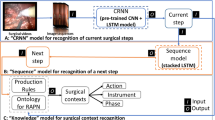Abstract
Learning production rules from continuous data streams, e.g. surgical videos, is a challenging problem. To learn production rules, we present a novel framework consisting of deep learning models and inductive logic programming (ILP) system for learning surgical workflow entities that are needed in subsequent surgical tasks, e.g. “what kind of instruments will be needed in the next step?” As a prototypical scenario, we analyzed the Robot-Assisted Partial Nephrectomy (RAPN) workflow. To verify our framework, first consistent and complete rules were learnt from the video annotations which can classify RAPN surgical workflow and temporal sequence at high-granularity e.g. steps. After we found that RAPN workflow is hierarchical, we used combination of learned predicates, presenting workflow hierarchy, to predict the information on the next step followed by a classification of step sequences with deep learning models. The predicted rules on the RAPN workflow was verified by an expert urologist and conforms with the standard workflow of RAPN.
Access this chapter
Tax calculation will be finalised at checkout
Purchases are for personal use only
Similar content being viewed by others
References
Nakawala, H., Bianchi, R., Pescatori, L.E., De Cobelli, O., Ferrigno, G., De Momi, E.: “Deep-Onto” network for surgical worflow and context recognition. Int. J. Comput. Assist. Radiol. Surg. 14(4), 685–696 (2019)
Nakawala, H., Ferrigno, G., De Momi, E.: Developement of an intelligent training system for Thoracentesis. Artif. Intell. Med. 84, 50–63 (2018)
Garcez, A., Besold, T.R., de Raedt, L., Földiak, P., Hitzler, P., Icard, T., Kühnberger, K.-U., Lamb, L.C., Miikkulainen, R., Silver, D.L.: Neural-symbolic learning and reasoning: contributions and challenges. In: 2015 AAAI Spring Symposium, Palo Alto, California (2015)
Bock, H.-H.: Data Mining Tasks and Methods: Classification: the Goal of Classification. Handbook of Data Mining and Knowledge Discovery. Oxford University Press, New York (2002)
Dutra, I., Nassif, H., Page, D., Shavik, J., Strigel, R.M., Wu, Y., Elezaby, M.E., Burnside, E.: Integrating machine learning and physician knowledge to improve the accuracy of breast biopsy. In: AMIA Annual Symposium Proceedings, pp. 349–355 (2011)
Burnside, E.S., Davis, J., Costa, V.S., de Castro Dutra, I., Kahn Jr., C.E., Fine, J., Page, D.: Knowledge discovery from structured mammography reports using inductive logic programming. In: AMIA Annual Symposium Proceedings, pp. 96–100 (2005)
Evans, R., Grefenstette, E.: Learning explanatory rules from noisy data. J. Artif. Intell. Res. 61(1), 1–64 (2018)
Hu, J.C., Treat, E., Filson, C.P., McLaren, I., Xiong, S., Stepanian, S., Hafez, K.S., Weizer, A.Z., Porter, J.: Technique and outcomes of robot-assisted retroperitoneoscopic partial nephrectomy: a multicenter study. Eur. J. Urol. 66, 542–549 (2014)
Srinivasan, A.: The Aleph Manual (1999). https://www.cs.ox.ac.uk/activities/programinduction/Aleph/aleph.html
Kipp, M.: Anvil–a generic annotation tool for multimodal dialogue. In: Proceedings of the 7th European Conference on Speech Communication and Technology (Eurospeech), pp. 1367–1370 (2001)
Agrawal, R., Imieliński, T., Swami, A.: Mining association rules between sets of items in large databases. In: Proceedings of the 1993 ACM SIGMOD International Conference on Management of Data - SIGMOD 1993, p. 207 (1993)
Acknowledgement
This research is funded by the European Research Council (ERC) under the European Union’s H2020 research and innovation programme (grant agreement No. 742671 “ARS”). This work was supported by European Union’s Horizon 2020 research and innovation programme (grant agreement No. 732515 “SMARTsurg”).
Author information
Authors and Affiliations
Corresponding author
Editor information
Editors and Affiliations
Ethics declarations
The authors confirm that there are no known conflicts of interest associated with this publication.
Rights and permissions
Copyright information
© 2020 Springer Nature Switzerland AG
About this paper
Cite this paper
Nakawala, H. et al. (2020). Toward a Neural-Symbolic Framework for Automated Workflow Analysis in Surgery. In: Henriques, J., Neves, N., de Carvalho, P. (eds) XV Mediterranean Conference on Medical and Biological Engineering and Computing – MEDICON 2019. MEDICON 2019. IFMBE Proceedings, vol 76. Springer, Cham. https://doi.org/10.1007/978-3-030-31635-8_192
Download citation
DOI: https://doi.org/10.1007/978-3-030-31635-8_192
Published:
Publisher Name: Springer, Cham
Print ISBN: 978-3-030-31634-1
Online ISBN: 978-3-030-31635-8
eBook Packages: EngineeringEngineering (R0)




